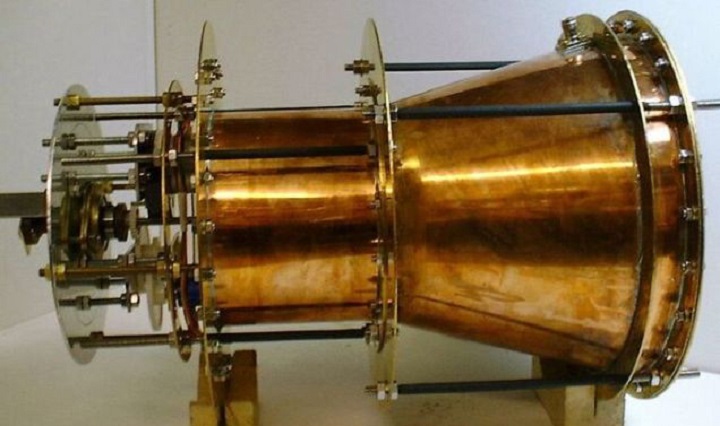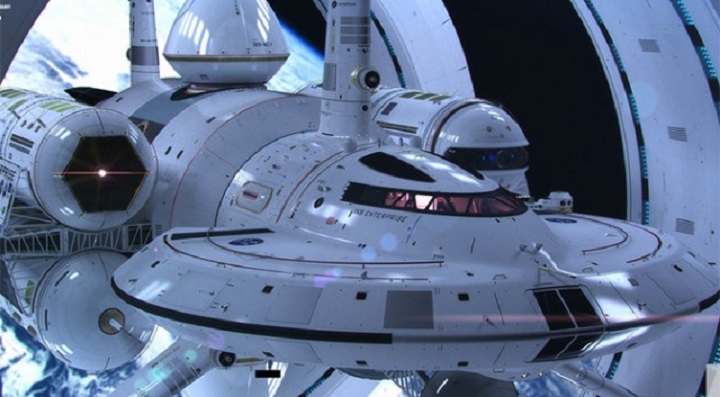
Last July, at the 50th AIAA/ASME/SAE/ASEE Joint Propulsion Conference in Cleveland, Ohio, NASA's advanced propulsion research made headlines by announcing that they had successfully tested a new design for an electromagnetic (EM) propulsion drive. Despite the fact this quantum vacuum plasma thruster appeared to defy the laws of conventional physics, the tests they conducted indicated that the engine worked.
And late last month, researchers at the Johnson Space Center again made waves when they indicated that they had successfully tested the drive in a vacuum, an indication that it might actually work in space. The announcement was made by NASA Eagleworks via NASASpaceFlight.com, triggering a major discussion about what this could mean for deep-space exploration, the physics of the drive itself, and whether or not this was a hoax.
The concept of the EM drive was originally proposed by Roger K Shawyer, a UK scientist who started Satellite Propulsion Research Ltd (SPR) to bring it to fruition. Built around the idea that electromagnetic microwave cavities might provide for the direct conversion of electrical energy to thrust, his concept was appealing because it offered propulsion without the need of propellant.
However, with no propellant being expelled, there be would nothing to balance the change in the spacecraft’s momentum during acceleration. Hence the skepticism, as such a system would violate the law of the Conservation of Momentum - which states that within a system, the amount of momentum remains constant and is neither created nor destroyed, but only changed through the action of forces.

First invented in 2001, the EM Drive concept could revolutionize space travel. Credit: NASA
But as Harold White, a NASA Eagleworks scientist, stated in July of 2014 after testing the drive: "[T]he EM Drive’s thrust was due to the Quantum Vacuum (the quantum state with the lowest possible energy) behaving like propellant ions behave in a MagnetoHydroDynamics drive (a method electrifying propellant and then directing it with magnetic fields to push a spacecraft in the opposite direction) for spacecraft propulsion."
In addition, in 2010, Prof. Juan Yang of the Northwestern Polytechnical University in Xi'an, China, began publishing a series of papers about her research into EM Drive technology. This culminated in her 2012 paper where she reported higher input power (2.5kW) and tested thrust (720mN) levels. In 2014, she further reported extensive tests involving internal temperature measurements with embedded thermocouples, which seemed to confirm that the system worked.
One problem with this theory is that such a system might not work in a closed vacuum. Hence, skeptics began to consider whether or not the measured thrust was in fact the result of environmental conditions external to the drive, such as natural thermal convection currents caused by the microwave heating, or some other factor that wouldn't be present in space.
What's more, the tests reported by Dr. White’s team in July 2014 were not conducted in a vacuum, and none of the tests reported by Prof. Yang in China or Mr. Shawyer in the UK were either. To address these concerns head-on, scientists at NASA's Eagleworks decided to test their EM Drive in a hard vacuum and, as Paul March (an engineer with Eagleworks) reported on NASASpaceFlight.com, they were successful.
"The NASASpaceflight.com group has given consideration to whether the experimental measurements of thrust force were the result of an artifact. Despite considerable effort within the NASASpaceflight.com forum to dismiss the reported thrust as an artifact, the EM Drive results have yet to be falsified.
"After consistent reports of thrust measurements from EM Drive experiments in the US, UK, and China – at thrust levels several thousand times in excess of a photon rocket, and now under hard vacuum conditions – the question of where the thrust is coming from deserves serious inquiry."

Artist Mark Rademaker's concept for the IXS Enterprise, a theoretical interstellar spacecraft. Credit: Mark Rademaker/flickr.com
The central insight here is that quantum vacuum fluctuations will occasionally and spontaneously create particles all throughout the vacuum of space, and that these short-lived particles could be put to useful work. The thruster apparently works by essentially turning these virtual particles into a plasma stream that it then expels out the back of the ship to generate thrust - much like a conventional fuel source.
The quantum fuel, though, spontaneously appears inside the thruster’s reaction area without even the need for collection or injection hardware. As such, it has immense benefits over conventional engine systems that require propellant of one kind or another. Naturally, these tests will need to be replicated elsewhere and peer-reviewed before they can be considered definitive, and the deeper questions of how the engine works still need to be addressed.
Still, they are encouraging given the fact that NASA is looking for a low-powered concept to make long-range missions possible and affordable, and this engine could very well be the one to make that happen. For example, if an EM Drive were to be installed in the International Space Station (ISS), it could provide the necessary delta-V thrust to compensate for the Station’s orbital decay. Such a propellant-less means of thrust could be a major cost-cutting measure and would eliminate the need for resupply and re-boosts from visiting vehicles
NASA would also find an EM Drive useful for the missions it has planned in the coming decades. These include towing an Near-Earth Object (NEO) closer to Earth for the sake of studying it, not to mention low Earth orbit (LEO) operations, and transit missions to the Moon, Mars, and the outer solar system. Looking ahead, multi-generation spaceships could also use a drive system of this kind for the sake of interstellar travel.
And if this concept should prove to be a pipe dream, NASA could always fall back on Ion propulsion, another low-powered concept that expels charged ions out of a nozzle to slowly but gradually build-up thrust. Then there's the proposal for nuclear-thermal propulsion (NTP), where fission engines would be used to heat hydrogen fuel to generate significant thrust while reducing both the cost of fuel and the weight of the craft.
And should both of these experiments fail, they could always put their faith in the Alcubierre Drive. FLT may be an even more far-fetched possibility, but it never hurts to dream!
Got ideas on space flight, or perhaps an idea that could have revolutionary implications? Then click here to launch a challenge with HeroX, and be prepared to make it a reality!
Top Image Credit: NASA SpaceFlight.com








